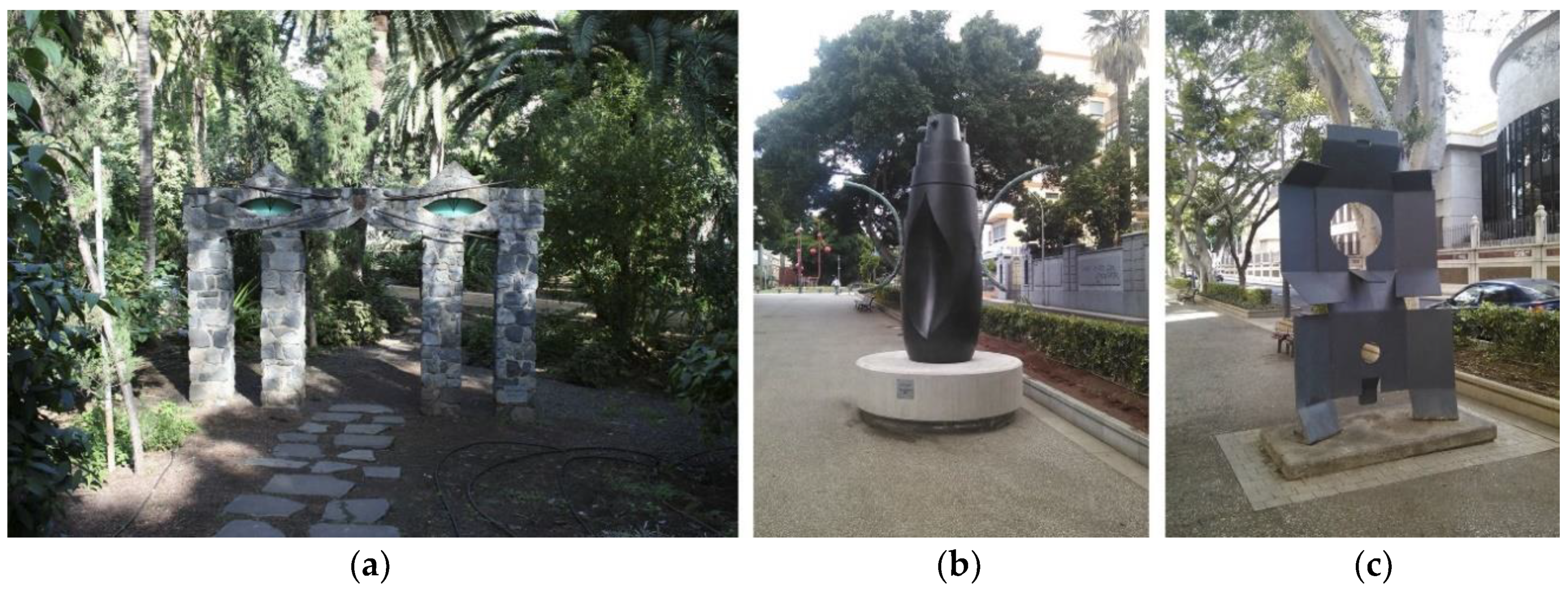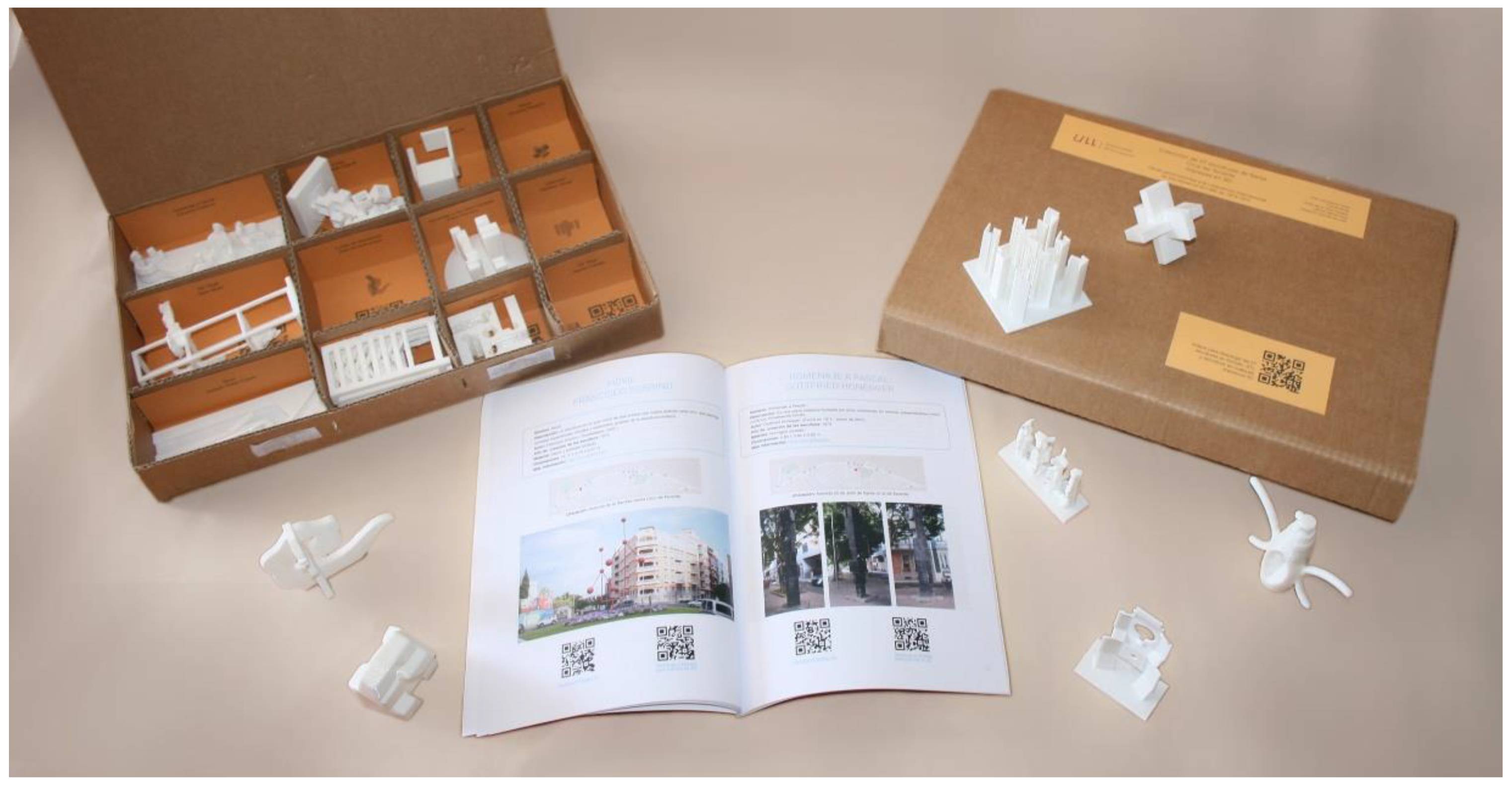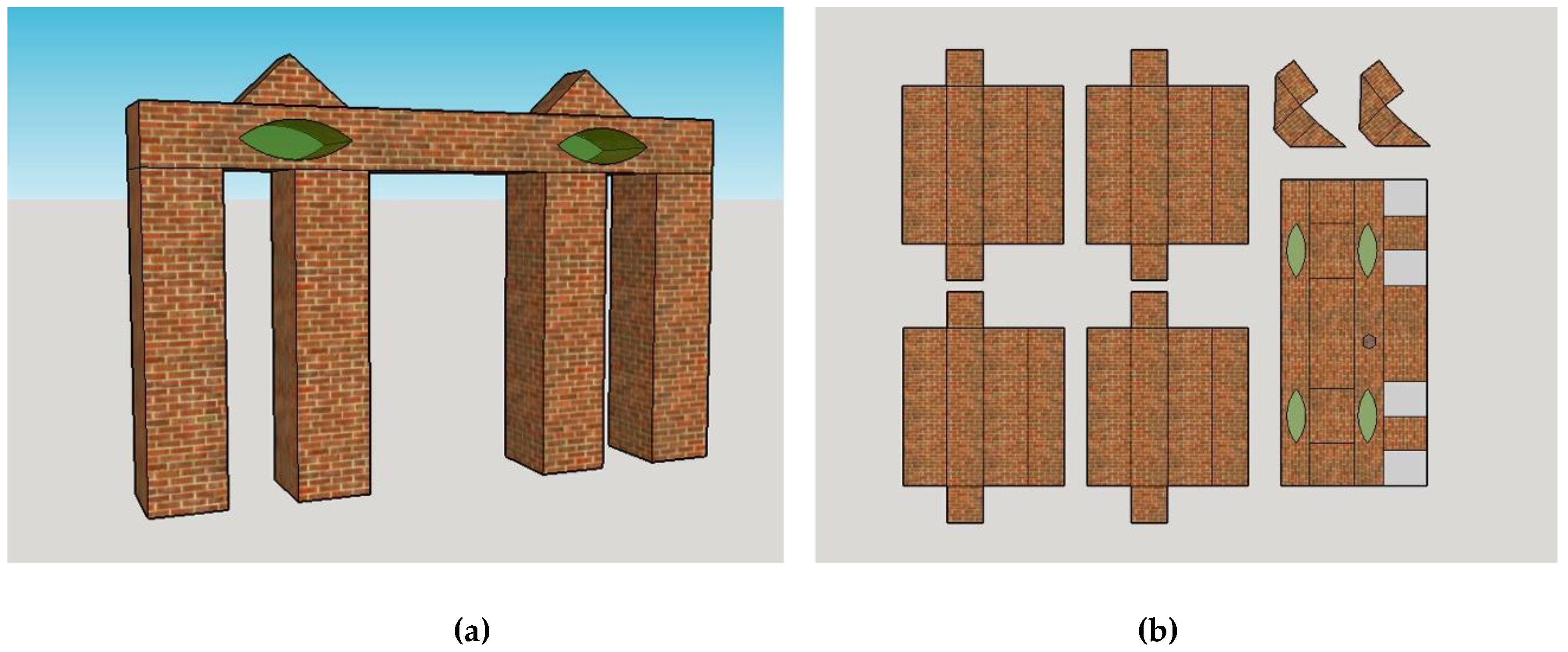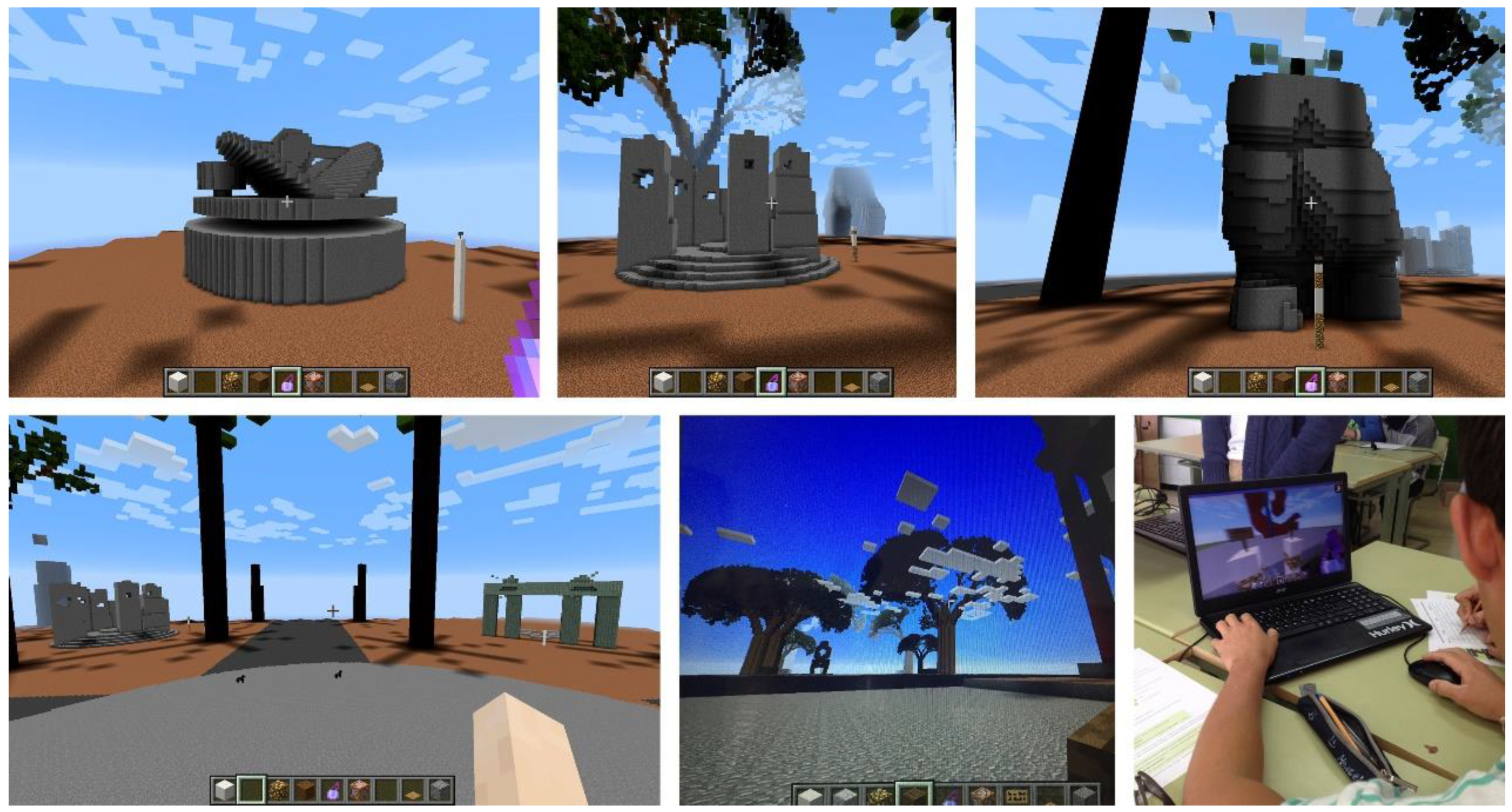Alternative Divulgation of the Local Sculptural Heritage: Construction of Paper Toys and Use of the Minecraft Video Game
Abstract
:1. Introduction
2. Materials and Methods
2.1. Alternatives for the Dissemination of Digital Heritage
2.2. 3D Digitalization
2.3. Diffusion via Paper Toys
2.4. Diffusion via the Virtual World of the Minecraft Video Game
3. Results
4. Conclusions
Supplementary Materials
Author Contributions
Funding
Conflicts of Interest
References
- DeCarli, G. Un Museo Sostenible: Museo y Comunidad en la Preservación Activa de su Patrimonio; Ed itorial Universidad Nacional (EUNA): Cuarto piso Bogotá D.C., Colombia, 2008. [Google Scholar]
- Martín-Cáceres, M.J.; Cuenca-López, J.M. Museum Management and Curatorship Communicating heritage in museums: Outlook, strategies and challenges through a SWOT analysis. Mus. Manag. Curatorship 2016, 31, 299–316. [Google Scholar] [CrossRef]
- Guerrero, J.A. Una tipología de los modelos para la enseñanza de las ciencias. Rev. Eureka sobre Enseñanza y Divulg. las Ciencias 2010, 7, 26–41. [Google Scholar]
- Clement, J.J.; Rea-Ramirez, M.A. (Eds.) Model Based Learning and Instruction in Science; Springer: Dordrecht, The Netherlands, 2008. [Google Scholar]
- Miles, H.C.; Wilson, A.T.; Wilson, A.T.; Wilson, A.T.; Wilson, A.T.; Wilson, A.T.; Ritsos, P.D.; Mearman, J.W.; Möller, K.; Karl, R.; et al. Alternative Representations of 3D-Reconstructed Heritage Data. J. Comput. Cult. Herit. 2015, 9, 1–18. [Google Scholar] [CrossRef] [Green Version]
- Greenop, K.; Landorf, C. digital cultural heritage: FUTURE VISIONS. 2018. Available online: https://www.ucl.ac.uk/bartlett/real-estate/events/2017/nov/digital-cultural-heritage-future-visions-2017-london-symposium (accessed on 11 November 2018).
- Koller, D.; Frischer, B.; Humphreys, G. Research challenges for digital archives of 3D cultural heritage models. J. Comput. Cult. Herit. 2009, 2, 1–17. [Google Scholar] [CrossRef]
- Foglino, F.; Melazzi, R.; Nogueira, A. Archivo Nacional del Patrimonio 3D. 2018. Available online: http://www.patrimonio3d.uy/ (accessed on 21 September 2018).
- Hollinger, R.E.; John, E.; Jacobs, H.; Moran-Collins, L.; Thome, C.; Zastrow, J.; Metallo, A.; Waibel, G.; Rossi, V. Tlingit-Smithsonian collaborations with 3D digitization of cultural objects. Museum Anthropol. Rev. 2013, 7, 201–253. [Google Scholar]
- Smithsonian Institution. “3d.si.edu,” 2018. Available online: https://3d.si.edu/ (accessed on 16 September 2018).
- Stanco, F.; Battiato, S.; Gallo, G. Digital Imaging for Cultural Heritage Preservation: Analysis, Restoration, and Reconstruction of Ancient Artworks; CRC Press: Boca Raton, FL, USA, 2011. [Google Scholar]
- Addison, A.C. Emerging trends in virtual heritage. IEEE Multimed. 2000, 7, 22–25. [Google Scholar] [CrossRef]
- Wessels, S.; Ruther, H.; Bhurtha, R.; Schroeder, R. Design and creation of a 3D virtual tour of the world heritage site of Petra, Jordan. Available online: http://africageoproceedings.org.za/wp-content/uploads/2014/06/97_Wessels_Ruther_Bhurta_Schroeder.pdf (accessed on 17 November 2018).
- González-Delgado, J.A.; Martínez-Graña, A.M.; Civis, J.; Sierro, F.J.; Goy, J.L.; Dabrio, C.J.; Ruiz, F.; González-Regalado, M.L.; Abad, M. Virtual 3D tour of the Neogene palaeontological heritage of Huelva (Guadalquivir Basin, Spain). Environ. Earth Sci. 2015, 73, 4609–4618. [Google Scholar] [CrossRef]
- Zamora-Musa, R.; Vélez, J.; Paez-Logreira, H. Evaluating Learnability in a 3D Heritage Tour. Presence Teleoperators Virtual Environ. 2018, 26, 366–377. [Google Scholar] [CrossRef]
- Bruno, F.; Bruno, S.; de Sensi, G.; Luchi, M.-L.; Mancuso, S.; Muzzupappa, M. From 3D reconstruction to virtual reality: A complete methodology for digital archaeological exhibition. J. Cult. Herit. 2010, 11, 42–49. [Google Scholar] [CrossRef]
- Kiourt, C.; Koutsoudis, A.; Pavlidis, G. DynaMus: A fully dynamic 3D virtual museum framework. J. Cult. Herit. 2016, 22, 984–991. [Google Scholar] [CrossRef]
- Barbieri, L.; Bruno, F.; Muzzupappa, M. Virtual museum system evaluation through user studies. J. Cult. Herit. 2017, 26, 101–108. [Google Scholar] [CrossRef]
- Kersten, T.P. 3D Models and Virtual Tours for a Museum Exhibition of Vietnamese Cultural Heritage Exhibits and Sites; Springer: Cham, Switzerland, 2018; pp. 528–538. [Google Scholar]
- Harrison, R. Excavating Second Life. J. Mater. Cult. 2009, 14, 75–106. [Google Scholar] [CrossRef]
- Dickey, M.D. Three-dimensional virtual worlds and distance learning: Two case studies of Active Worlds as a medium for distance education. Br. J. Educ. Technol. 2005, 36, 439–451. [Google Scholar] [CrossRef]
- Varinlioglu, G.; Aslankan, A.; Alankus, G.; Mura, G. Raising Awareness for Digital Heritage through Serious Game the Teos of Dionysos. 2017. Available online: https://www.academia.edu/37686584/Raising_Awareness_for_Digital_Heritage_through_Serious_Game (accessed on 17 November 2018).
- Bellotti, F.; Berta, R.; de Gloria, A.; D’ursi, A.; Fiore, V. A serious game model for cultural heritage. J. Comput. Cult. Herit. 2012, 5, 1–27. [Google Scholar] [CrossRef]
- Gîrbacia, F.; Butnariu, S.; Petre, O.A.; Postelnicu, C.C. Virtual restoration of deteriorated religious heritage objects using augmented reality technologies system for diagnosis and therapy of spine diseases-spine view project medical robotics systems view project girbacia florin virtual restoration of deterior. Eur. J. Sci. Theol. 2013, 9, 223–231. [Google Scholar]
- Guimaraes, F.; Figueiredo, M.; Rodrigues, J. Augmented Reality and Storytelling in heritage application in public gardens: Caloust Gulbenkian Foundation Garden. In 2015 Digital Heritage; IEEE: Valencia, Spain, 2015; pp. 317–320. [Google Scholar]
- Caruso, G.; Carulli, M.; Bordegoni, M. Augmented Reality System for the Visualization and Interaction with 3D Digital Models in a Wide Environment. Comput. Aided. Des. Appl. 2015, 12, 86–95. [Google Scholar] [CrossRef]
- Educa. 3D Sculpture Puzzle Venus de Milo - Educa Borras. 2018. Available online: http://www.educaborras.com/ficha-producto/16504/ (accessed on 21 September 2018).
- Ravensburger. 3D Puzzle-Building. 2018. Available online: https://www.ravensburger.org/es/productos/3d-puzzle/3d-puzzle-building/category.html (accessed on 20 September 2018).
- Lego. LEGO® Architecture. 2018. Available online: https://www.lego.com/es-es/themes/architecture/products/statue-of-liberty-21042 (accessed on 20 September 2018).
- 1001 maquetas. Edificios en miniatura, todas las maquetas. 2018. Available online: https://www.1001maquetas.es/2009-edificios (accessed on 20 September 2018).
- Redetiner. Recortables: sueños de papel. 2018. Available online: https://docplayer.es/31950008-Recortables-suenos-de-papel-hojas-didacticas.html (accessed on 20 September 2018).
- Froebel, F. The education of man; A. Lovell & Company: New York, NY, USA, 1885. [Google Scholar]
- Katayose, S.; Usami, R. Papercraft sheet for fabricating a toy. U.S. Patent No. 6,136,400, 2000. [Google Scholar]
- Whitney, J.P.; Sreetharan, P.S.; Ma, K.Y.; Wood, R.J. Pop-up book MEMS. J. Micromech. Microeng. 2011, 21, 115021. [Google Scholar] [CrossRef]
- Dawley, L.; Dede, C. Situated Learning in Virtual Worlds and Immersive Simulations. In Handbook of Research on Educational Communications and Technology; Springer: New York, NY, USA, 2014; pp. 723–734. [Google Scholar]
- Short, D. Teaching Scientific Concepts using a Virtual World-Minecraft Hands on Teaching scientific concepts using a virtual world-Minecraft. Teach. Sci. 2012, 58, 55–58. [Google Scholar]
- Duncan, C. Well Played; ETC Press: Halifax, NS, Canada, 2011; Volume 1. [Google Scholar]
- Canossa, A.; Martinez, J.B.; Togelius, J. Give me a reason to dig Minecraft and psychology of motivation. In Proceedings of the 2013 IEEE Conference on Computational Inteligence in Games (CIG), Niagara Falls, ON, Canada, 11–13 August 2013. [Google Scholar]
- Overby, A.; Jones, B.L. Virtual LEGOs: Incorporating Minecraft into the Art Education Curriculum. Art Educ. 2015, 68, 21–27. [Google Scholar] [CrossRef]
- Saez-Lopez, J.-M.; Dominguez-Garrido, M.-C. Integración Pedagógica De La Aplicación Minecraft Edu En Educación Primaria: Un Estudio De Caso (Pegagogical Integration of the Application Minecraft Edu in Elementary School: A Case Study). 2014. Available online: https://idus.us.es/xmlui/handle/11441/45794 (accessed on 17 November 2018).
- Pérez, J.L.S.; de la Torre Cantero, J.; Dorta, N.M.; Carrera, C.C.; Díaz, D.M.; Meier, C. Creación e inserción de modelos 3D en Minecraft para la mejora de la competencia espacial y creativa en Ingeniería. 2017. Available online: https://dialnet.unirioja.es/servlet/articulo?codigo=6123821 (accessed on 17 November 2018).
- Saorín-Pérez, J.L.; Carbonell-Carrera, C.; de la Torre-Cantero, J.; Meier, C.; Alemán, D.D. Three-Dimensional Interpretation of Sculptural Heritage with Digital and Tangible 3D Printed Replicas Carlos CARBONELL-CARRERA. TOJET Turkish Online J. Educ. Technol. 2017, 16, 161–169. [Google Scholar]
- De la Torre-Cantero, J.; Saorín, J.L.; Meier, C.; Melián-Díaz, D.; Alemán, M.D.-D. Creación de réplicas de patrimonio escultórico mediante reconstrucción 3D e impresoras 3D de bajo coste para uso en entornos educativos. Arte, Individuo y Soc. 2015, 27, 429–446. [Google Scholar] [CrossRef]
- Mitani, J.; Suzuki, H. Making papercraft toys from meshes using strip-based approximate unfolding. ACM Trans. Graphics 2004, 23, 259–263. [Google Scholar] [CrossRef]
- Shatz, I.; Tal, A.; Leifman, G. Paper craft models from meshes. Vis. Comput. 2006, 22, 825–834. [Google Scholar] [CrossRef] [Green Version]
- Massarwi, F.; Gotsman, C.; Elber, G. Papercraft Models using Generalized Cylinders. In Proceedings of the 15th Pacific Conference on Computer Graphics and Applications (PG’07), Maui, HI, USA, 29 October–2 November 2007; pp. 148–157. [Google Scholar]
- Mahedero, L.S. Tinkercad, una forma distinta de aprender a través de la fabricación digital. Comun. y Pedagog. Nuevas Tecnol. y Recur. didácticos, ISSN 1136-7733, No 281-282, 2015 (Ejemplar Dedic. a Gamificación), pág. 37, no. 281–282. 2015. Available online: https://dialnet.unirioja.es/servlet/articulo?codigo=5121837 (accessed on 17 November 2018).







| Sculpture | Finished | Total Finished | Average Time |
|---|---|---|---|
| Femme Bouitelle (Joan Miró) | no | 0 | - |
| Introversión (Josep María Subirachs) | yes | 2 | 30 min |
| Macla (Eduardo Gregorio) | yes | 3 | 38 min |
| Monument to the cat (Óscar Domínguez) | yes | 2 | 37 min |
| Hombre (María Simón) | yes | 1 | 40 min |
| Untitled (Feliciano Hernández) | no | 0 | - |
| Móvil (Francisco Sobrino) | no | 0 | - |
| Homenaje a Millares (Claude Viseux) | yes | 2 | 35 min |
| Tribute to the Canary Islands (Pablo Serrano) | yes | 1 | 50 min |
| Dado para 13 (Remigio Mendiburu) | yes | 2 | 87 min |
| Questions | Results N = 27 | |
|---|---|---|
| 1 | Building paper toys of sculptures is an interesting resource for learning about sculptural heritage. | 3.78 (1.01) |
| 2 | Building paper toys is an interesting activity to help understand the three-dimensionality of the sculptures better. | 4.41 (0.84) |
| 3 | I would like to carry out more activities like this in the subject. | 4.74 (0.66) |
| 4 | The building of the paper toy has been easy. | 3.48 (1.09) |
| Group | Start Time | Finish Time | Total Minutes |
|---|---|---|---|
| Group 1 | 9:00 am | 9:45 am | 45 |
| Group 2 | 9:00 am | 9:45 am | 45 |
| Group 3 | 9:15 am | 9:45 am | 30 |
| Group 4 | 9:00 am | 9:45 am | 45 |
| Group 5 | 9:00 am | 9:45 am | 45 |
| Question | Results N = 16 | |
|---|---|---|
| 1 | I would like to do more activities based on Minecraft | 4.29 (0.73) |
| 2 | I believe that the use of Minecraft increases my motivation to study and learn in class | 3.71 (1.07) |
| 3 | Learning with Minecraft is a good complement in combination with traditional materials | 3.79 (0.97) |
| 4 | It has been easy for me to operate in the world of Minecraft | 3.93 (1.07) |
| 5 | The use of a world of Minecraft is useful for the teaching–learning of urban sculptural patrimony | 4.14 (0.66) |
| 6 | Carrying out the activity has made me aware of the urban sculptures of Santa Cruz | 4.14 (0.77) |
© 2018 by the authors. Licensee MDPI, Basel, Switzerland. This article is an open access article distributed under the terms and conditions of the Creative Commons Attribution (CC BY) license (http://creativecommons.org/licenses/by/4.0/).
Share and Cite
Meier, C.; Saorín, J.L.; De la Torre-Cantero, J.; Díaz-Alemán, M.D. Alternative Divulgation of the Local Sculptural Heritage: Construction of Paper Toys and Use of the Minecraft Video Game. Sustainability 2018, 10, 4262. https://doi.org/10.3390/su10114262
Meier C, Saorín JL, De la Torre-Cantero J, Díaz-Alemán MD. Alternative Divulgation of the Local Sculptural Heritage: Construction of Paper Toys and Use of the Minecraft Video Game. Sustainability. 2018; 10(11):4262. https://doi.org/10.3390/su10114262
Chicago/Turabian StyleMeier, Cecile, Jose Luis Saorín, Jorge De la Torre-Cantero, and Manuel Drago Díaz-Alemán. 2018. "Alternative Divulgation of the Local Sculptural Heritage: Construction of Paper Toys and Use of the Minecraft Video Game" Sustainability 10, no. 11: 4262. https://doi.org/10.3390/su10114262
APA StyleMeier, C., Saorín, J. L., De la Torre-Cantero, J., & Díaz-Alemán, M. D. (2018). Alternative Divulgation of the Local Sculptural Heritage: Construction of Paper Toys and Use of the Minecraft Video Game. Sustainability, 10(11), 4262. https://doi.org/10.3390/su10114262






